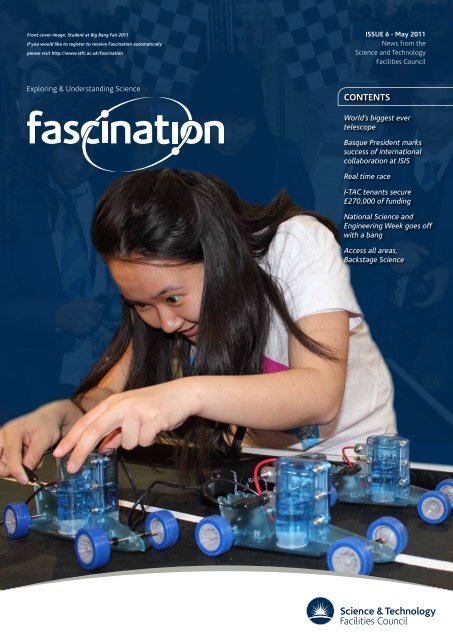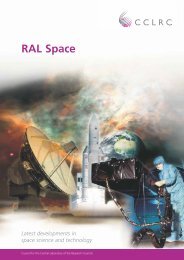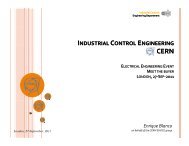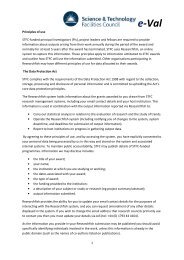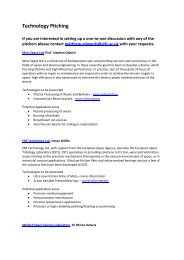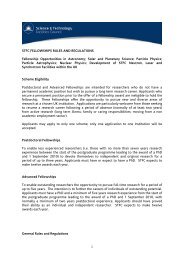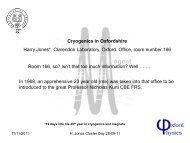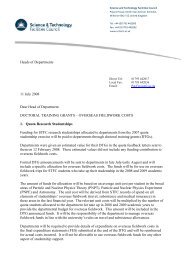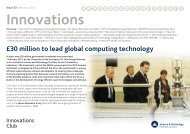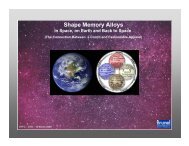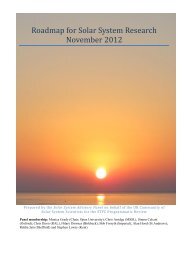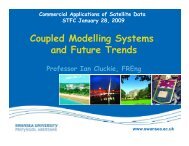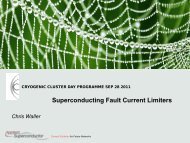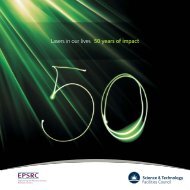Fascination - Science & Technology Facilities Council
Fascination - Science & Technology Facilities Council
Fascination - Science & Technology Facilities Council
Create successful ePaper yourself
Turn your PDF publications into a flip-book with our unique Google optimized e-Paper software.
Front cover image: Student at Big Bang Fair 2011<br />
If you would like to register to receive <strong>Fascination</strong> automatically<br />
please visit http://www.stfc.ac.uk/fascination<br />
ISSUE 6 - May 2011<br />
News from the<br />
<strong>Science</strong> and <strong>Technology</strong><br />
<strong>Facilities</strong> <strong>Council</strong><br />
Exploring & Understanding <strong>Science</strong><br />
CONTENTS<br />
World’s biggest ever<br />
telescope<br />
Basque President marks<br />
success of international<br />
collaboration at ISIS<br />
Real time race<br />
I-TAC tenants secure<br />
£270,000 of funding<br />
National <strong>Science</strong> and<br />
Engineering Week goes off<br />
with a bang<br />
Access all areas,<br />
Backstage <strong>Science</strong>
New project will promote equality<br />
and diversity in HE research careers<br />
A new project ‘Every researcher counts’ led by Vitae and<br />
commissioned by the Higher Education Funding <strong>Council</strong> for<br />
England (HEFCE) is set to improve equality and diversity for<br />
research staff within the HE sector. Many of the challenges<br />
relating to equality and diversity are systemic within the<br />
HE sector, particularly for research staff. These can create<br />
a difficult environment for researchers, but particularly<br />
disadvantages some groups including women, disabled and<br />
black and minority ethnic researchers.<br />
The project is aiming to develop a network of at least<br />
50 individuals to act as ‘equality and diversity champions’<br />
from over 50 different HEIs across the UK. Vitae is currently<br />
seeking nominations from equality and diversity specialists,<br />
widening participation staff, Human Resources staff,<br />
academics, HEI senior managers or principal investigators<br />
(PIs). Champions will be expected to raise awareness of the<br />
researcher equality and diversity agenda within HEIs, use<br />
and distribute resources to PIs and staff developers, attend<br />
regional ‘train-the-trainer’ events, and provide feedback to<br />
the project team.<br />
The project is an important part of the HEFCE<br />
implementation strategy for the Concordat to Support the<br />
Career Development of Researchers.<br />
More information about the ‘Every researcher counts’,<br />
its wider objectives and outcomes is available on the Vitae<br />
website www.vitae.ac.uk For ECU guidance to HEIs regarding<br />
equality and diversity please visit: www.ecu.ac.uk<br />
The first science paper from the<br />
Research Complex at Harwell<br />
Research by scientists in the Laser for <strong>Science</strong> Facility, based at<br />
the Research Complex at Harwell (RcaH), and colleagues at the<br />
University of Bristol has shown how the energy generated by<br />
chemical reactions in solution is dissipated to the environment in<br />
less than a billionth of a second.<br />
Using the unique capabilities of STFC’s ULTRA laser system,<br />
scientists from the University of Bristol have been able to watch<br />
a chemical reaction happening in solution with more detail than<br />
ever before. This could lead to improved drug design for medical<br />
therapies and catalysts for industrial processing, and pave the<br />
way for further applications in bio- and atmospheric chemistry.<br />
The superfast ULTRA laser system was able to monitor the<br />
transfer of energy from the reaction product to the surrounding<br />
solvent by following changes in chemical bonds much faster than<br />
was possible previously. The research is featured on the cover of<br />
the journal <strong>Science</strong>.<br />
<strong>Science</strong> Paper. http://www.sciencemag.org/<br />
content/331/6023.cover-expansion<br />
2
Getting ready for the world’s<br />
biggest ever telescope<br />
Plans for the world’s biggest telescope - the<br />
Square Kilometre Array (SKA) - have advanced<br />
significantly with a decision to locate the<br />
project office at Jodrell Bank Observatory near<br />
Manchester.<br />
The SKA is a €1.5 billion global science project to build the<br />
world’s largest and most sensitive radio telescope. The SKA<br />
will be capable of answering some of the most fundamental<br />
questions about the Universe.<br />
STFC’s Professor John Womersley, chair of the Founding<br />
Board, said: “Given the current economic environment, it<br />
is reassuring that so many partners have recognised the<br />
importance of supporting the SKA.<br />
Our partners have taken this step not only because of the<br />
inspirational nature of the discoveries that the SKA will make,<br />
but also because of the economic benefits that international<br />
megascience projects can bring to participating countries.”<br />
The SKA project will drive technology development in<br />
antennas, signal transport, signal processing, and software<br />
and computing. Spin off innovations in these areas will benefit<br />
other systems that process large volumes of data. The design,<br />
construction and operation of the SKA has the potential to<br />
impact skills development in science, engineering and in<br />
associated industries, not only in the host countries but in all<br />
project partners.<br />
Artist’s impression of the SKA dishes<br />
(Credit: SPDO / TDP / DRAO / Swinburne<br />
Astronomy Productions)<br />
£11M investment destined<br />
to make air travel safer<br />
Universities and <strong>Science</strong> Minister<br />
David Willetts announced £11M<br />
funding to build a new testing<br />
facility that will make electronics<br />
systems less susceptible to the<br />
potentially catastrophic effects<br />
of cosmic neutrons, during a visit<br />
to STFC’s Rutherford Appleton<br />
Laboratory.<br />
Funding from the Large <strong>Facilities</strong><br />
Capital Fund will be used to build<br />
a new beamline on the world<br />
leading ISIS neutron source.<br />
Called ‘Chipir’, the beamline will<br />
be used to simulate the effects<br />
of cosmic radiation which can<br />
cause the failure of microchips<br />
in sensitive electronics systems.<br />
Problems can vary from wiping a<br />
device’s memory to the complete<br />
destruction of the electronics - a<br />
serious issue at altitude. In a single<br />
hour, ISIS will be able to replicate<br />
the effects of 100 years of flying<br />
time.<br />
David Willetts, Minister<br />
for <strong>Science</strong> at STFC’s ISIS<br />
facility<br />
3
<strong>Technology</strong> Breakthrough<br />
Back in issue 2 we reported on the EMMA accelerator - A brand<br />
new technology that promises a range of applications from<br />
treating cancer to powering safer nuclear reactors. EMMA is<br />
located at STFC’s Daresbury Laboratory. EMMA is a proof of<br />
principle prototype for a brand new type of particle accelerator,<br />
designed by an international team of scientists, including a<br />
number of the UK’s top universities and institutes. A major<br />
part of the BASROC CONFORM project, EMMA is funded by the<br />
Research <strong>Council</strong>s UK (RCUK) Basic <strong>Technology</strong> programme.<br />
EMMA has now achieved its most significant milestone<br />
yet. For the first time, an electron beam was steered around<br />
the circumference of EMMA’s ring and then successfully<br />
accelerated to 18 MeV. This momentous milestone, and a world<br />
first, not only confirms that the design of the most technically<br />
demanding aspects of EMMA is sound, it also demonstrates the<br />
feasibility of EMMA’s technology, which now paves the way for<br />
the construction of a whole new generation of more powerful,<br />
yet more compact and economical accelerators.<br />
http://www.conform.ac.uk<br />
ALMA up date<br />
On 30 March the ALMA Observatory, an array of millimetre<br />
wave telescopes being constructed in the Atacama Desert of<br />
Chile, issued its first Call for Proposals.<br />
ALMA now has 16 of its planned 50 antennas available<br />
and is ready for early scientific exploitation. As the world’s<br />
largest millimetre wave interferometer ALMA is a very powerful<br />
and complex instrument; to make it as easy as possible for<br />
astronomers to plan and make their observations, a special<br />
ALMA Observing Tool has been developed by a team led by<br />
Dr Alan Bridger of the UK Astronomy <strong>Technology</strong> Centre (UK<br />
ATC). The software, which is the Astronomers’ main interface<br />
to ALMA, has been in development since 2002 and is already<br />
in use for commissioning of the facility. The tool is the first<br />
of its kind for an interferometer and its 500,000 lines of code<br />
were written by a team including members from Edinburgh and<br />
Mitako (Tokyo), the team interacts with other ALMA developers<br />
in 12 sites across the world.<br />
The UK ATC software group is part of a large collaboration,<br />
which includes the European Southern Observatory and the<br />
National Astronomical Observatory of Japan. Alan and many<br />
of his team have years of experience developing integrated<br />
observation preparation, execution and analysis software,<br />
examples of which were deployed on the JCMT and UKIRT<br />
telescopes in Hawaii during 1998 and 1999. Packages like<br />
this make planning and executing observations very efficient<br />
and flexible, so it is possible to match observing plans to<br />
atmospheric conditions and maximise the scientific return from<br />
these powerful facilities.<br />
For more information visit<br />
www.almaobservatory.org<br />
www.ukatc.ac.uk<br />
The Atacama Large Millimeter<br />
Array (ALMA)<br />
4
Basque President marks success of<br />
international collaboration at ISIS<br />
Patxi Lopez, President of the Basque Country and Dr Andrew Taylor, ISIS Director,<br />
with the steel vacuum tank manufactured in the Basque Country for installation at<br />
the ISIS Neutron Source.<br />
The scientific and technical<br />
collaboration between STFC’s<br />
ISIS neutron source and the<br />
Basque Country has been<br />
celebrated during a visit by<br />
the region’s President Patxi<br />
Lopez.<br />
International<br />
collaborations have enabled<br />
ISIS to continually push the<br />
boundaries of accelerator<br />
technology and neutron<br />
instrumentation to deliver<br />
innovative and highimpact<br />
science. Exchanging<br />
technological expertise has<br />
enabled Basque companies<br />
to manufacture high-tech<br />
equipment for ISIS and other<br />
similar projects.<br />
Dr Andrew Taylor, Director,<br />
ISIS, said: “For more than<br />
twenty years, ISIS has been<br />
a world leader, a position<br />
we maintain because of<br />
the excellence of our staff<br />
and of our international<br />
partnerships.”<br />
High temperature<br />
optical sensors<br />
Wave-Phire Sensor<br />
STFC’s spin out company Oxsensis is developing fibre optical<br />
sensors for hostile environments, including extremely high<br />
temperatures and pressures. They will be used in ultra high<br />
temperature situations such as gas turbines for power<br />
generation, aero-engines industrial processes and other<br />
hostile environments such as poisonous gas detection and<br />
petrochemical processes.<br />
This is contributing to the development of a range of<br />
internal combustion engines including reciprocating engines<br />
and gas turbines.<br />
Internal combustion engine development continues to<br />
address a number of challenges including, for example, the<br />
management of stable lean burn combustion at temperatures<br />
up to 1000˚C across wide operating ranges, and the use of<br />
varying fuel compositions. The drive to reduce fuel burn is<br />
relentless and early thermodynamic wins are now giving<br />
way to harder and more complex steps which are needed to<br />
ensure continued progress. Sophisticated control strategies<br />
are emerging, which require reliable and ‘actionable’<br />
information in order to succeed.<br />
Initially sensors were trialled in relevant test rigs<br />
constructed within Oxsensis laboratory facilities. Such<br />
rigs are designed to recreate aspects of the harsh engine<br />
environment such as the high temperatures, pressures,<br />
vibration levels and acoustic effects, however, none can truly<br />
combine all of these aspects to fully recreate the real-life<br />
environment.<br />
After completion of these initial laboratory based<br />
demonstrations, the systems were deployed in full engine<br />
operation for land-based tests on smaller aero engines. A<br />
helicopter engine offered the first test berth, followed by a<br />
turbojet engine and other land-based aero engine tests, some<br />
of which are ongoing. A total of 50,000 combined running<br />
hours have now been achieved with five sensors at the<br />
Didcot B Power station.<br />
Oxsensis is extending its R&D experience into a number<br />
of reciprocating engine test environments during 2011. There<br />
are two main engine areas for evaluation; in-cylinder and<br />
exhaust manifold locations.<br />
Oxsensis will run dynamic pressure sensors in a<br />
commercial development engine, in a 1000°C location,<br />
upstream of a turbocharger. Oxsensis will also trial incylinder<br />
sensors on another research automotive test bed.<br />
The next stage will involve work with a number of<br />
research groups to provide them with the opportunity<br />
to evaluate multi-parameter sensing systems, first in the<br />
laboratory, and then in rigs and also engine tests.<br />
http://www.oxsensis.com/<br />
5
Real time race<br />
not just playing games<br />
Based at the Daresbury Innovation Centre Real Time Race<br />
(RTR) develops three dimensional immersive video graphics,<br />
initially for the computer game market. If you look on its<br />
website www.rtr.co/ you will see how they produce a<br />
perfect video representation of the Lotus Test Track. This<br />
system, called iflex, has two advantages, it is significantly<br />
more efficient than using CGI, taking a fraction of the time of<br />
conventional means and it produces quality images with TV<br />
like reality.<br />
The key to the patented system is sophisticated software<br />
that combines military grade GPS, high resolution laser range<br />
finding and 3D video. It is so sensitive that it can detect<br />
minor changes in the road surface, such as white marking<br />
lines.<br />
Matching the iflex images with a physics engine enables<br />
you to design the capabilities of a virtual physics engine<br />
vehicle, be it a racing car, motorcycle or off road vehicle to<br />
replicate exactly the behaviour that you want.<br />
This enables car manufacturers, advertising agencies<br />
and race track operators to have effective high quality<br />
simulations. Furthermore it can provide a realistic driver<br />
training aid for emergency services.<br />
Of course the applications of this system are not restricted<br />
to racing simulations. The accuracy of the system makes<br />
it ideal for sophisticated engineering analysis. Caterpillar,<br />
the earth moving equipment manufacturer, uses the iflex<br />
system to accurately map quarry floors, including the<br />
surface, potholes and rocks and then match this with 3D<br />
videos of the suspension and tyre movements to get a better<br />
understanding of the impact of different environments on<br />
their vehicles endurance and performance.<br />
The latest addition to RTR’s range is itherm, merging iflex<br />
with a 3D thermal imaging system that enables mass surveys<br />
of cities, industrial plant, road surfaces etc<br />
www.rtr.co/<br />
6
OCF enCORE service uses STFC<br />
server cluster to power Lola Cars<br />
The use of server clusters or ‘supercomputers’ to aid research<br />
and development is not new. However, accessing their<br />
processing power as a service from a third-party supplier is<br />
certainly an innovation.<br />
In December 2010 STFC signed a unique agreement with OCF<br />
plc to make use of spare processing power from its own IBM<br />
iDataPlex server cluster. OCF will make that processing power<br />
available to UK businesses of any service through its enCORE<br />
service. Naturally OCF works very closely with STFC (including<br />
becoming a tenant at the Daresbury <strong>Science</strong> and Innovation<br />
Campus).<br />
Phil Tiller, Senior Aerodynamicist at Lola Cars, a racing car<br />
engineering company, has been successfully using enCORE<br />
and STFC’s spare power for around four weeks. He is testing<br />
Computation Fluid Dynamics (CFD) research and development<br />
cases.<br />
Phil comments: “We have been able to use enCORE to reduce<br />
processing time for our test cases to just five hours, down from<br />
up to two days. It means we can get information out to the<br />
engineers on the track in advance of weekend racing.”<br />
He continues: “We always want a bigger computer, but the<br />
business does not have infinite resources. Using enCORE is a like a<br />
pay-as-you-go mobile, you can spend as you use it, when you use<br />
it and not at other times. It becomes a manageable running cost.”<br />
enCORE has been successfully tested by a range of companies<br />
since December, including Lola Cars, and is now available to any<br />
UK business.<br />
www.ocf.co.uk<br />
Dyson Racing Lola-Mazda<br />
LMP at Long Beach<br />
(Credit Lola/Regis Lefebure)<br />
Using X-rays to fight tooth decay<br />
Tooth decay is very common, and affects people of all ages.<br />
The problem is caused by sticky deposits called plaque that<br />
collect, most commonly around the gum line and the grooved<br />
surfaces of the teeth. So how could a team of researchers<br />
from the UK and Japan use the Diamond synchrotron, based<br />
at the Harwell Oxford Campus, and the Photon Factory in<br />
Tsukuba City, Japan, to solve the 3D structure of an enzyme<br />
that plays a key role in tooth decay<br />
caused by sugar?<br />
Tooth decay can occur when<br />
a biofilm, or dental plaque as it is<br />
more commonly known, is formed<br />
by a large and sticky glucose<br />
polymer called glucan. The glucan<br />
biofilm contains bacteria and food<br />
debris and forms on the surface<br />
of the tooth. As they grow, the<br />
bacteria secrete acids which break<br />
down the tooth’s hard enamel<br />
on the surface. The structural<br />
information published in the Journal<br />
of Molecular Biology provides a<br />
critical insight into how the enzyme<br />
‘GTF-SI’, a glucansucrase, forms<br />
glucan, the sticky biofilm substance.<br />
“With the use of the Diamond<br />
synchrotron and the Photon<br />
Factory we have been able to solve not only the structure<br />
of the enzyme alone but also its structure when bound to<br />
an existing inhibitor,” says Sohei Ito from the Laboratory of<br />
Food Protein Engineering at the University of Shizuoka in<br />
graphical abstract (of a glucansucrase enzyme from the dental caries<br />
pathogen Streptococcus mutans forming a biofilm, and the acids<br />
within) credit: Reprinted from the Journal of Molecular Biology, Vol<br />
408, Issue 2, Keisuke Ito et al. ‘Crystal Structure of Glucansucrase<br />
from the Dental Caries Pathogen Streptococcus mutans’. Pages 177-<br />
378, Copyright (2011), with permission from Elsevier.<br />
Japan, and lead researcher on the project. “Several inhibitors<br />
that prevent this type of enzyme forming glucan have<br />
been identified but to date there has been little structural<br />
information available. With the data we collected at Diamond<br />
and the Photon Factory, we now have a better understanding<br />
of how the enzyme functions and how it can be stopped. This<br />
structural information should be useful in the design of novel<br />
inhibitors that will prevent the<br />
biofilm formation by glucansucrases<br />
and reduce the risk of possible side<br />
effects such as hypoglycaemia.<br />
These novel inhibitors could be<br />
incorporated into toothpaste and<br />
mouthwash, making them more<br />
effective at preventing tooth<br />
decay.”<br />
The structural data collection<br />
at the Diamond synchrotron<br />
was carried out on the I02<br />
Macromolecular Crystallography<br />
(MX) experimental station. Principal<br />
Beamline Scientist, Professor<br />
Thomas Sorensen, says, “Knowing<br />
the 3D structure of the enzyme is<br />
like knowing the shape of a lock<br />
you need to find a key for – it makes<br />
it much easier to find the right key<br />
that will fit. In this case, the inhibitor acts like the key, fitting<br />
into the lock in just the right way so that it can do its job.”<br />
www.diamond.ac.uk, University of Shizuoka<br />
visit http://eng.u-shizuoka-ken.ac.jp/index.html<br />
7
I-TAC Tenants secure<br />
£270,000 of funding<br />
The Innovations <strong>Technology</strong> Access Centre (I-TAC) prides<br />
itself on supporting SME’s in the early stages of their business<br />
development by providing access to world class facilities,<br />
high specification equipment and STFC expertise. After its first<br />
year in operation, I-TAC has achieved significantly more than<br />
expected. Tenant companies have employed 12 new people,<br />
£270,000 of funding and investment has been secured by the<br />
tenants and over 200 people have been shown around I-TAC.<br />
Within I-TAC, tenants cover the areas of energy, healthcare<br />
and environment, in line with the government’s and STFC’s<br />
strategy for addressing solutions to these grand challenges. The<br />
running of the I-TAC Futures Challenge (detailed in <strong>Fascination</strong><br />
issue 5) allowed companies to win access to I-TAC’s facilities in<br />
these key target areas. The STFC Futures Programme was the<br />
support behind the competition.<br />
The Futures Programme was STFC’s response to ensuring<br />
that skills and technology originally developed to address<br />
fundamental research questions are harnessed effectively to<br />
provide solutions to the global challenges.<br />
Since they have been on site this is what just three of the<br />
companies have achieved;<br />
Butters Innovations Ltd has gained £195,000 in funding<br />
since being based in I-TAC. £25,000 came from achieving a<br />
Disruptive Innovation Award from a <strong>Technology</strong> Strategy Board<br />
(TSB) competition. This has enabled them to commission the<br />
Engineering <strong>Technology</strong> Centre on the Daresbury <strong>Science</strong> and<br />
Innovation Campus (DSIC) to co-develop the software, electronics<br />
and mechanical elements of their MoRoW II stroke patient<br />
rehabilitation device. A working electro-mechanical prototype<br />
will undergo clinical trials later this year. The same project gained<br />
Butters Innovation a £10,000 Strategic IP Audit grant from the<br />
UK Intellectual Property Office; they have also received £160,000<br />
from the NHS I4I programme. “It’s very exciting to work with<br />
such an experienced and talented team of hardware and software<br />
engineers. Working at I-TAC has enabled us to fill a gap in our<br />
own capabilities. We have also recently incorporated a new<br />
company called MoRoW Ltd who are helping us commercialise<br />
the device we are building. Working with the team at I-TAC<br />
has helped us apply for equity funding which will help us fully<br />
commercialise the project.” Butters Innovations Ltd project<br />
partners include University of Salford, Medilink North West and<br />
PDS Engineering.<br />
8<br />
TopCat Research Ltd aims to provide effective and cost<br />
conscious analytical products for the food, pharmaceutical and<br />
environmental markets with products based on immunoassay<br />
(ELISA) and DNA detection (PCR) platforms. Director, Anthony<br />
Cope, said “Bringing my business to I-TAC has enabled me to<br />
gain £50,000 from the NW Fund to achieve proof of concept.<br />
We’re developing a pregnancy testing technology that will be<br />
used to help breeding programmes for endangered animals -<br />
nothing like this exists at the moment. Being based at I-TAC was<br />
a huge positive when applying for funding. This type of support<br />
was not available anywhere else. I look forward to growing<br />
and developing my ideas and taking on new staff in the months<br />
ahead.”<br />
BiSN Technologies Ltd offers a range of services to help oil<br />
and gas operators in a variety of areas, from materials testing<br />
to research and development in microbiologically enhanced oil<br />
recovery. BiSN has recently gained £25,000 in funding from the<br />
<strong>Technology</strong> Strategy Board. Paul Carragher and Leo Richards said:<br />
“The equipment and facilities, both at Daresbury and throughout<br />
the STFC network, allow us to compete at a world leading level.<br />
The range of services we can now offer matches, and in most<br />
cases exceeds, what our competitors can offer. In addition, the<br />
STFC and campus network has already proved valuable, having<br />
linked us to academic and industrial contacts. “<br />
www.itac.stfc.ac.uk and www.stfc.ac.uk/Futures
National <strong>Science</strong> and<br />
Engineering Week<br />
goes off with a BANG<br />
Like many organisations STFC was<br />
heavily involved with events during<br />
and around National <strong>Science</strong> and<br />
Engineering week.<br />
With over 29,000 people attending<br />
The Big Bang 2011, one of the UK’s<br />
biggest science events for young<br />
people celebrating science, technology,<br />
engineering and mathematics, STFC were<br />
proud to send a team from ISIS. The<br />
team together with experts from Cella<br />
Energy (<strong>Fascination</strong> issue 5, STFC spin out<br />
company) had a stand on the theme of low<br />
carbon energy. The stand featured mini<br />
hydrogen-powered cars and an array of<br />
novel hydrogen storage material samples.<br />
For the scientists and engineers working<br />
on the stand, it was a rare opportunity to<br />
talk to children and young people about<br />
their work at ISIS: “I had an excellent<br />
time”, said Atahl Nathanson, a UCL PhD<br />
student working with ISIS on hydrogen<br />
storage. “It was an excellent opportunity<br />
to explain how hydrogen fuel cells work<br />
to a completely different audience. It was<br />
also a great chance to see what other<br />
organisations are up to!”<br />
“We all really<br />
enjoyed it and<br />
found the level<br />
about right - quite<br />
challenging but<br />
grounded in<br />
things that they<br />
were familiar<br />
with. It brought<br />
the subject alive<br />
for the students.<br />
Please add us to<br />
your mailing list!<br />
9
Pulling together<br />
to get top results<br />
How do you see inside something if it is too small to see even with the most<br />
powerful microscope? To look inside a molecule and see the arrangement<br />
of the atoms? Crystallography is one potential answer. Crystallography is a<br />
process which provides 3-dimensional information from proteins and helps<br />
provide basic understanding of biological processes on a molecular level.<br />
Crystallography is the method<br />
that gives you the best resolution .<br />
Out of the original seven beamlines<br />
at Diamond three were specifically<br />
for use with this process and<br />
now 5 dedicated instruments for<br />
macromolecular crystallography<br />
(MX) are operational. Microfocus MX<br />
beamline provides X-ray beams down<br />
to 5 microns allowing investigations<br />
of samples with dimensions of only<br />
a few micrometres, instead of a<br />
few tens of microns for standard<br />
experiments.<br />
A brand new set up at the Harwell<br />
Oxford Campus is expected to open<br />
up a whole new realm of possibilities<br />
in crystallography. For the first time<br />
micro-crystals can be captured and placed onto sample<br />
holders used on the Diamond MX beamlines in a very specific<br />
way through the use of laser tweezers – previously this has<br />
been a random selection process. For X-ray studies being able<br />
to select the bigger crystals can improve the resolution of the<br />
obtained protein structure significantly. Using laser tweezers<br />
makes the capture of specific sized crystals in the sample<br />
possible.<br />
Typical CPV crystal preparation.<br />
Average sample size is around 5 x 5 x 5 microns.<br />
A ‘spiders web’ has been designed<br />
by STFC’s Micro and Nanotechnology<br />
Centre (MNTC) to sit under the<br />
mesh that the identified crystals are<br />
placed on – this ensures that even<br />
smaller crystals can be captured.<br />
This means many more crystals can<br />
be examined – usually those samples<br />
would be lost because there was no<br />
system capable of analysing them<br />
so important information could<br />
have been lost. The overall time for<br />
capturing and analysing crystals will<br />
be drastically improved. It will be far<br />
more time effective than the random<br />
process. Previously you may have<br />
needed to go through as many as<br />
300 samples to collect results from the<br />
correct size of crystal now you can just collect the specific<br />
samples you need.<br />
The collaboration stretches right across the Harwell Oxford<br />
Campus . The facilities involved are Diamond, Central Laser<br />
Facility MNTC and the Research Complex at Harwell together<br />
with Zeiss Microimaging. Although not yet fully operational<br />
this collaboration will offer many benefits. Once the required<br />
modifications to the process have been made the plan will be<br />
to integrate this system into the Diamond proposal system.<br />
ESA TTN Showcase<br />
STFC Daresbury Laboratory,<br />
17 May<br />
including an introduction to STFC<br />
and UK ESA <strong>Technology</strong> transfer activities<br />
http://www.stfc.ac.uk/Business+and+Innovation/22067.aspx<br />
10
Daresbury’s first I-TAC<br />
tenant cleans up with<br />
supermarket giant<br />
Bug battling firm Byotrol, which researched and developed its<br />
revolutionary hygiene technology at STFC’s I-TAC, has worked with<br />
McBrides, Europe’s leading provider of Private Label Household products,<br />
to launch a ground-breaking cleaning spray for Tesco.<br />
Byotrol’s patented technology, which is used<br />
in wipes, sprays and mousses to combat the<br />
spread of viruses and superbugs, including<br />
MRSA, is the main bacteria-killing ingredient<br />
in Tesco’s own-brand multi-surface spray. In<br />
contrast to old technologies, Byotrol contains<br />
no alcohol or bleach so is gentler on skin and<br />
the environment and is significantly longer<br />
lasting than traditional but harsher cleaning<br />
products currently on the market.<br />
Manchester-based Byotrol relocated<br />
its entire R&D division from Germany to<br />
Daresbury’s I-TAC in 2009 to develop and<br />
enhance its patented technology.<br />
A-level students tell us what they think of<br />
this year’s Particle Physics Masterclasses<br />
Hundreds of A-level students went to STFC’s Daresbury and<br />
Rutherford Appleton Laboratories during National <strong>Science</strong><br />
and Engineering Week (11-20 March 2011) to take part in<br />
Particle Physics Masterclasses. The classes are designed to<br />
inspire students to pursue careers in science and fill key jobs<br />
in science, technology, engineering and mathematics.<br />
STFC Press Officer Lucy Stone went to speak to a few of the<br />
students at Rutherford Appleton Laboratory (RAL):<br />
Audio file of Lucy Stone’s interview with Masterclass students<br />
http://www.stfc.ac.uk/resources/mp/PPMFINALAUDIO.mp3<br />
The students at RAL learnt about contemporary research in<br />
particle physics. Their day<br />
included a visit to the ISIS<br />
neutron source or Diamond<br />
Light Source, two of the<br />
world’s leading centres<br />
for materials research,<br />
both driven by high-power<br />
particle accelerators. The<br />
event included talks by<br />
particle physicists from RAL<br />
and CERN, and a computerbased<br />
workshop using real<br />
data from the Large Hadron<br />
Collider.<br />
Students from schools across the North West joined scientists<br />
from the Cockcroft Institute (CI) at Daresbury Laboratory for the<br />
annual Particle Physics Masterclass. Building on the successes<br />
of previous years, and acknowledging the unique opportunities<br />
available in running a masterclass at a national laboratory, the<br />
CI outreach group obtained agreement from the Institute of<br />
Physics to shift the emphasis towards accelerator design and<br />
performance, thereby showcasing the technologies that facilitate<br />
particle physics experiments. This was essentially the first particle<br />
and accelerator physics masterclass.<br />
Some new activities were run this year, including an exercise<br />
to show how the basic design parameters for the Diamond Light<br />
Source were calculated from the target specifications, and a<br />
new and challenging exercise to study how an electron bunch<br />
is both compressed and rotated in space to maximise the peak<br />
current before it is used to drive the free-electron laser on the<br />
ALICE accelerator. These were backed by other tried-and-tested<br />
exercises to estimate the injector beam energy in ALICE using<br />
only some basic physics and a few simple measurements, plus<br />
particle physics simulations, and further supported by lectures<br />
on the quark model of<br />
particle physics and aspects<br />
of particle accelerator<br />
science.<br />
Scientists and engineers<br />
from RAL Space were also<br />
very busy engaging with<br />
over 1000 members of the<br />
public in science week:On<br />
11 and 12 March, families<br />
and members of the public<br />
received expert tuition<br />
on the stars in our night<br />
sky during activities organised as part of the Reading <strong>Science</strong><br />
Week. Barry Kellett, from RAL Space, explained the make-up of<br />
our Moon with a hands-on display of Moon rocks and meteorites,<br />
whilst Reading Astronomical Society were on hand to assist with<br />
stargazing.<br />
Several graduates from the robotics team took a robot<br />
challenge to the Changing Perspectives Festival at Bristol,<br />
organised by Bristol University; http://www.bristol.ac.uk/<br />
public-engagement/events/2011/37.html.<br />
11
Access all areas<br />
Backstage <strong>Science</strong><br />
<strong>Science</strong> is a subject that<br />
fascinates most of us. What<br />
makes our science so exciting,<br />
the study of materials, the<br />
solving of problems?<br />
Have you ever wanted to look<br />
inside a particle accelerator? Meet<br />
a plasma scientist? Here is your<br />
opportunity to take a peak inside<br />
STFC.<br />
Backstage <strong>Science</strong> is a small<br />
selection of videos about STFC. The<br />
footage includes interviews with<br />
some our scientists and a fantastic<br />
unparalleled opportunity to see<br />
behind the scenes at many of our<br />
facilities, most of which can’t easily be<br />
accessed.<br />
From fitting a new instrument on<br />
ISIS (set of super microscopes) to<br />
creating a vacuum better than on the<br />
Moon - STFC science and technology<br />
covers many areas.<br />
Take a look for yourself:<br />
http://www.youtube.com/<br />
Backstage<strong>Science</strong><br />
Royal Society pairing scheme:<br />
for MPs, civil servants and scientists<br />
The Royal Society is looking for scientists to take part in its pairing<br />
scheme for MPs, civil servants and scientists.<br />
The scheme starts in Autumn with the ‘Week in<br />
Westminster’: a programme of activities for the scientists<br />
including seminars, workshops, shadowing opportunities<br />
and a tour of Westminster.<br />
Applications are now open to scientists with an interest<br />
in science policy, a proven ability to communicate their<br />
research and at least three years of post-doctoral research<br />
experience.<br />
For more information, please visit: royalsociety.org/pairing-scheme<br />
Contacts<br />
<strong>Science</strong> and <strong>Technology</strong> <strong>Facilities</strong> <strong>Council</strong>,<br />
Polaris House, North Star Avenue, Swindon,<br />
SN2 1SZ<br />
Tel: +44 (0)1793 442000<br />
Fax: +44 (0)1793 442002<br />
Email: fascination@stfc.ac.uk web: www.stfc.ac.uk<br />
<strong>Fascination</strong> is produced six times a year.<br />
To subscribe please go to:<br />
http://www.stfc.ac.uk/stfcforms/NewsletterBooking.aspx<br />
Edited by Jane Binks.<br />
Designed by STFC Media Services. Printed by the Research<br />
<strong>Council</strong>’s Joint Reprographics Service.<br />
If you have comments on this publication, or suggestions for<br />
future editions please email fascination@stfc.ac.uk


